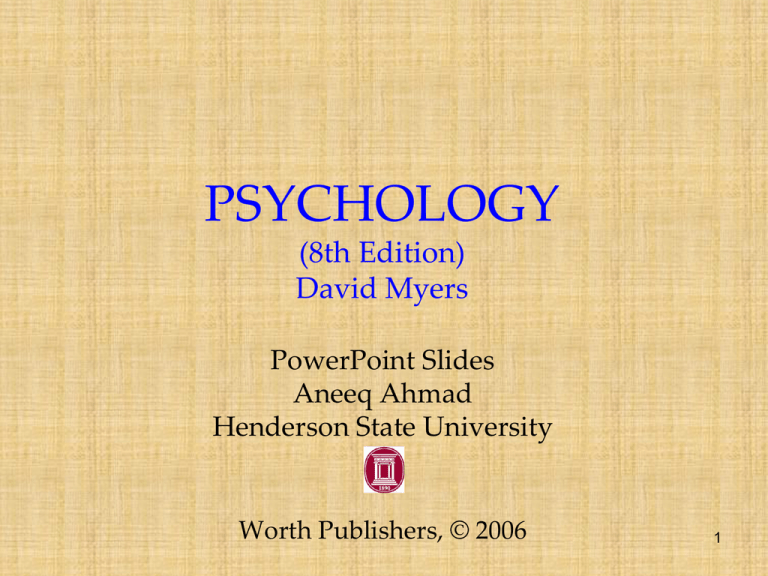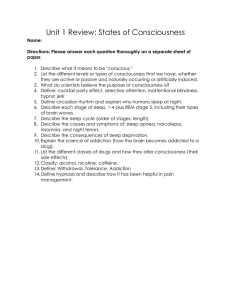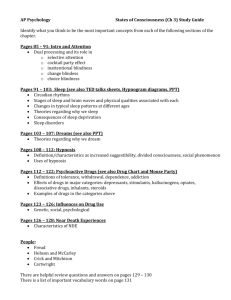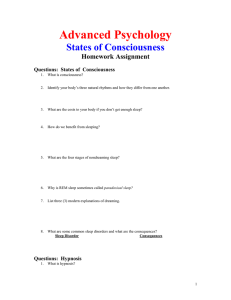
PSYCHOLOGY
(8th Edition)
David Myers
PowerPoint Slides
Aneeq Ahmad
Henderson State University
Worth Publishers, © 2006
1
States of
Consciousness
Chapter 7
2
States of Consciousness
Consciousness and
Information Processing
Sleep and Dreams
Biological Rhythms
The Rhythm of Sleep
Sleep Disorders
Dreams
3
States of Consciousness
Hypnosis
Facts and Falsehoods
Is Hypnosis an Altered State of
Consciousness?
Drugs and Consciousness
Dependence and Addiction
Psychoactive Drugs
Influences on Drug Use
4
States of Consciousness
Near-Death Experiences
5
History of Consciousness
1. Psychology began as a science of
consciousness.
2. Behaviorists rejected consciousness, instead
concentrating on direct observations of
behavior.
3. However, after 1960, mental concepts
(consciousness) started reentering
psychology.
4. Currently cognitive psychologists and others
6
have returned to a study of consciousness.
Forms of Consciousness
AP Photo/ Ricardo Mazalan
Stuart Franklin/ Magnum Photos
Christine Brune
Bill Ling/ Digital Vision/ Getty Images
Consciousness, modern psychologists believe, is
an awareness of ourselves and our environment.
7
Consciousness Terminology – Give
Examples of Each:
• Conscious—what you are aware of
• Nonconscious—totally removed from
consciousness
• Preconscious—outside of awareness, but
easily brought to mind
• Unconscious or subconscious—level of
mental activity that influences consciousness
8
but is not conscious
Neuroscience & Consciousness
Neuroscientists believe that consciousness
emerges from the interaction of individual
brain events much like a chord that is created
from different musical notes.
9
Consciousness
• Experiments show consciousness lagging
behind the brain events that evoke it.
• Thus decision making can be at the
unconscious level before the conscious level
10
Consciousness & Information
Processing
The unconscious mind processes information
simultaneously on multiple tracks, while the conscious
mind processes information sequentially.
Conscious mind
Unconscious mind
11
Sleep & Dreams
Sleep – the irresistible tempter to whom we
inevitably succumb.
Mysteries about sleep and dreams have just started
unraveling in sleep laboratories around the world.
12
Biological Rhythms
Biological rhythms are controlled by
internal “biological clocks.”
1. Annual cycles: On an annual cycle, geese
migrate, grizzly bears hibernate, and humans
experience seasonal variations in appetite,
sleep, and mood. Seasonal Affective Disorder
(SAD) is a mood disorder people experience
during dark winter months.
13
Biological Rhythms
2. 28-day cycles: The
female menstrual
cycle averages 28
days. Research
shows menstruation
may not affect
moods.
14
Biological Rhythms
3. 24-hour cycles: Humans experience 24-hour
cycles of varying alertness (sleep), body
temperature, and growth hormone secretion.
4. 90-minute cycles: We go through various stages
of sleep in 90-minute cycles.
15
Rhythm of Sleep
Illustration © Cynthia Turner 2003
Circadian Rhythms occur on a 24-hour cycle and
include sleep and wakefulness, which are
disrupted during transcontinental flights.
Light triggers the suprachiasmatic nucleus to decrease
melatonin from the pineal gland in the morning
and increase it at night fall.
16
Sleep Rhythms
• Are you a lark or an owl? Why do you think so?
• Have you had your biological clock disrupted?
How did it affect you?
• How does it work?
• Linked (entrained) to environmental cues, but
will occur without
17
Sleep Rhythms
• Light activates light-sensitive retinal proteins,
which trigger signals to a brain region that
controls the circadian clock.
• Most young adults adopt a 25 hour day. Does
this apply to you? What is the effect? Are you
a sleep zombie?
18
AM I SLEEP DEPRIVED?
• 1. I need an alarm clock in order to wake up at
the appropriate time.
• 2. It’s a struggle for me to get out of bed in the
morning.
• 3. Weekday mornings I hit the snooze button
several times to get more sleep.
• 4. I feel tired, irritable, and stressed-out during
the week.
• 5. I have trouble concentrating and
remembering.
19
AM I SLEEP DEPRIVED?
• 6. I feel slow with critical thinking, problem
solving, and being creative.
• 7. I often fall asleep watching TV.
• 8. I often fall asleep in boring classes in
warm rooms.
• 9. I often fall asleep after heavy meals.
• 10. I often fall asleep while relaxing after
dinner.
20
AM I SLEEP DEPRIVED?
• 11. I often fall asleep within five minutes
of getting into bed.
• 12. I often feel drowsy while driving.
• 13. I often sleep extra hours on weekend
mornings.
• 14. I often need a nap to get through the
day.
• 15. I have dark circles around my eyes.
21
SLEEP DEFICIT SCALE
• 4 or less: adequate sleep
• 5 or 6: most days adequate sleep
• 7 or 8: evidence of sleep debt that may cause a
noticeable reduction in work efficiency
• 9-11: definitely a large sleep debt; random errors in work
• 12-14: quality of life suffers; less interested in things,
less likely to socialize; may be a bit accident prone;
temporary memory defects
• 15 and above: sleep debt a major problem; should seek
professional help if attempts to increase sleep are
unsuccessful
22
Why do we sleep?
We spend one-third of
our lives sleeping.
Jose Luis Pelaez, Inc./ Corbis
If an individual
remains awake for
several days, they
deteriorate in terms of
immune function,
concentration, and
accidents.
23
Accidents
Frequency of accidents increase with loss of sleep
24
Sleep Deprivation
1. Fatigue and subsequent death.
2. Impaired concentration.
3. Emotional irritability.
4. Depressed immune system.
5. Greater vulnerability.
25
Why do we sleep?
• Sleep debt: brain will keep an accurate count
for up to 2 weeks
• Large sleep debt: “makes you stupid”
26
Sleep Stages
Measuring sleep: About every 90 minutes, we
pass through a cycle of five distinct sleep stages.
Hank Morgan/ Rainbow
27
Awake & Alert
During strong mental engagement, the brain
exhibits low amplitude and fast, irregular beta
waves (15-30 cps). An awake person involved in a
conversation shows beta activity.
Beta Waves
28
Awake but Relaxed
When an individual closes his eyes but remains
awake, his brain activity slows down to a large
amplitude and slow, regular alpha waves (9-14
cps). A meditating person exhibits an alpha brain
activity.
29
Sleep Stages 1-2
During early, light sleep (stages 1-2) the brain
enters a high-amplitude, slow, regular wave form
called theta waves (5-8 cps). A person who is
daydreaming shows theta activity.
Theta Waves
30
Sleep Stages 3-4
During deepest sleep (stages 3-4), brain activity
slows down. There are large-amplitude, slow
delta waves (1.5-4 cps).
31
Stage 5: REM Sleep
After reaching the deepest sleep stage (4), the
sleep cycle starts moving backward towards stage
1. Although still asleep, the brain engages in lowamplitude, fast and regular beta waves (15-40 cps)
much like awake-aroused state.
A person during this sleep exhibits
Rapid Eye Movements (REM)
and reports vivid dreams.
32
90-Minute Cycles During Sleep
With each 90-minute cycle, stage 4 sleep decreases
and the duration of REM sleep increases.
33
REM Sleep
• Retrace 1-2-3-4-3-2—REM (90 minutes)/then
repeat
• REM—active sleep
– Resembles awake state
– Paralysis due to relaxed muscles
– Paradoxical Sleep—body internally aroused and
externally calm
34
ACTIVITY
• Read over Astronaut scenario
• Complete Telemetry Evaluations for each
astronaut
• Record all answers in your notebooks
35
Sleep Theories
1. Sleep Protects: Sleeping in the darkness when
predators loomed about kept our ancestors out
of harm’s way.
2. Sleep Recuperates: Sleep helps restore and
repair brain tissue.
3. Sleep Helps Remembering: Sleep restores and
rebuilds our fading memories.
4. Sleep and Growth: During sleep, the pituitary
gland releases growth hormone. Older people
release less of this hormone and sleep less.
36
SLEEP DISORDERS
• Have you personally experienced any
sleep problems?
– Sleep talking
– Sleep walking
– Nightmares
– Insomnia
– Others?
37
Sleep Disorders
1.
Parasomnias: Sleep Walking (Somnabulism)and Sleep
Talking (Stage 4 Disorders):
Tends to run in families
Children most prone, rare after 40
Usually harmless and unrecalled
Those who have the deepest and lengthiest Stage 4 are the most likely
to experience
2. Nightmares: Frightening dreams that wake a sleeper from
REM.
3. Night terrors (Incubus Attacks): Sudden arousal from sleep
with intense fear accompanied by physiological reactions
(e.g., rapid heart rate, perspiration) Occur during Stage 4
Sleep, within 2 or 3 hours of falling asleep, and are seldom
remembered.
38
Sleep Disorders
4. Narcolepsy: Overpowering urge to fall asleep that
may occur while talking or standing up.
Usually lasts less than 5 minutes
Rarely, may collapse into brief period of REM sleep
Caused by an absence of a hypothalamic neural center that
produces a neurotransmitter called hypocretin
5. Obstructive Sleep apnea: Failure to breathe when
asleep.
Mostly overweight men
Often unaware
Risk factors: snores, feels tired during the day, high blood
39
pressure
Sleep Disorders
6. Insomnia: persistent problems in falling or staying
asleep
Effect of Stress: One less hour
Age: from middle age on, sleep is usually
interrupted
•
We typically overestimate the amount of time
(double) it takes to fall back to sleep and
underestimate the length of time we sleep.
•
How can you combat insomnia?
40
SLEEP STRATEGIES
• A “true” answer to one or more items from Am I
Sleep Deprived indicates that some aspects of a
person’s life-style are interfering with his or her
sleep. Treating insomnia:
– Sleep restriction: no more than 7 hours in bed; avoid
naps; arise at same time every morning, including
weekends
– Stimulus control: go to bed only when sleep; bed only
for sleep or relaxing activities; if you don’t fall asleep
in 20 minute, stop trying and do something relaxing
– Relaxation response training; use soothing visual
imagery; rhythmic breathing, and muscle relaxation,
at first in the daytime and then before sleep
41
Sleep Disorders
7. SIDS – SUDDEN INFANT DEATH SYNDROME
How can SIDS be prevented?
8. REM Behavior Disorder (not in text):
Paralysis normal during REM does not exist
May “act out” dreams
Generally men
9. Delayed Sleep Phase Syndrome:
Cannot fall asleep or wake up at appropriate times
10. Restless Legs Syndrome: neurological movement
disorder. An irresisitible urge to move their legs. Creeping,
crawling, pulling or tingling sensations.
42
SLEEP/DREAM LOGS
In small groups, calculate for the group:
– The mean number of hours/night you sleep
– The mean number of dreams/night you remember
Analyze the characteristics of dreams,
determine patterns within your group
Share your indepth description of your
dream, analyze reasons why you
remembered that particular dream
43
What do we dream about?
• “Hallucinations of the sleeping mind”
44
Dreams
The link between REM
sleep and dreaming
has opened up a new
era of dream research.
45
What do we Dream?
1. Negative Emotional Content: 8 out of 10
dreams have negative emotional content.
2. Failure Dreams: People commonly dream
about failure, being attacked, pursued,
rejected, or struck with misfortune.
3. Sexual Dreams: Contrary to our thinking,
sexual dreams are sparse. Sexual dreams in
men are 1 in 10; and in women 1 in 30.
4. Dreams of Gender: Women dream of men
and women equally; men dream more about
men than women.
46
Why do we dream?
1. Sigmund Freud suggested that dreams
provide a psychic safety valve to discharge
unacceptable feelings.
a. The dream’s manifest (apparent) content may
also have symbolic meanings (latent content) that
signify our unacceptable feelings. “Royal road to
the unconscious”
b. Fulfillment of wishes, esp erotic wishes
2. Information Processing: Dreams may help
sift, sort, and fix a day’s experiences in our
memories.
47
Why do we dream?
3. Physiological
Function: Dreams
provide the sleeping
brain with periodic
stimulation to
develop and preserve
neural pathways.
Neural networks of
newborns are quickly
developing; therefore,
they need more sleep.
48
Why do we dream?
4.
5.
Activation-Synthesis Theory: Suggests that the brain
engages in a lot of random neural activity. Dreams make
sense of this activity. (Hobson and McCarley)
Cognitive Development: Some researchers argue that we
dream as a part of brain maturation and cognitive
development.
Limbic System is active (emotion), frontal lobe
(inhibition, rational thought) is idle during REM
What theories were proposed by the Nova Video:
What are Dreams?
All dream researchers believe we need REM sleep. When
deprived of REM sleep and then allowed to sleep,
we show increased REM sleep called REM Rebound.
49
Dream Theories
Summary
50
Hypnosis
http://iddiokrysto.blog.excite.it
A social interaction in
which one person (the
hypnotist) suggests to
another (the subject)
that certain
perceptions, feelings,
thoughts, or behaviors
will spontaneously
occur.
Hypnos: Greek god of sleep
51
Mesmerism
http://www.general-anaesthesia.com
Credit for the popularity
of hypnosis goes to
Franz Anton Mesmer, a
physician, who
mistakenly thought he
discovered “animal
magnetism.” Some of his
patients experienced a
trancelike state and felt
better upon waking up.
Franz Mesmer (1734 - 1815)
52
Who can be hypnotized?
• Susceptibility: degree to which people
respond to hypnotic suggestion:
– 10-15% are excellent subjects
– 10% difficult or impossible
– 75-80% between extremes
53
Characteristics while hypnotized
(Bernstein)
•
•
•
•
•
•
Reduced planfulness
Attention is redistributed
Ability to fantasize is enhanced
Reduced reality testing
Good at role taking
Posthypnotic amnesia
54
Aspects of Hypnosis
1. Posthypnotic Suggestion: Suggestion carried
out after the subject is no longer hypnotized.
2. Posthypnotic Amnesia: Supposed inability to
recall what one experienced during hypnosis.
55
Hypnotic Feats
Strength, stamina, and perceptual and memory
abilities similarly affect those who are
hypnotized and those who are not
hypnotized.
56
Facts and Falsehood
Those who practice hypnosis agree that its power
resides in the subject’s openness to suggestion.
Can anyone experience hypnosis?
Yes, to some extent.
Can hypnosis enhance recall of
forgotten events?
No.
57
Facts and Falsehood
Can hypnosis force people to act
against their will?
No.
Can hypnosis be therapeutic?
Yes. Self-suggestion
can heal too.
Can hypnosis alleviate pain?
Yes. Lamaze can
do that too.
58
Hypnosis (continued)
• Can hypnosis force people to act against
their will?
– Research with control groups shows no
evidence
– Shows how most people can be induced by
an authoritative person to commit unlikely
acts.
59
Is Hypnosis an Altered State of
Consciousness?
Courtesy of News and Publications Service, Stanford University
1. Social Influence Theory:
Hypnotic subjects may simply
be imaginative actors playing
a social role.
2. Divided Consciousness
Theory: Hypnosis is a special
state of dissociated (divided)
consciousness (Hilgard, 1986,
1992).
(Hilgard, 1992)
60
Mimi Forsyth
Both Theories
61
MEDITATION – DEEP
RELAXATION
• Definition: a set of
techniques designed
to create an altered
state of
consciousness
characterized by inner
peace and tranquility.
62
Meditation—Deep Relaxation (con’t)
•
•
•
•
Methods
Focusing—narrowing attention to just one
thing long enough for person meditating to
stop thinking about anything and to
experience nothing but pure awareness
Quiet environment
Mental Device (e.g.—mantra)
Passive Attitude
63
Meditation—Deep Relaxation (con’t)
What Happens:
•
Decreased respiration, heart rate, muscle
tension, blood pressure, oxygen consumption
•
Brain wave activity changes
64
Meditation—Deep Relaxation (con’t)
Benefits:
• Decreases stress related problems
• Increased mental health
• Reduction in death rate among nursing home
patients, heart attack patients
65
Meditation—Deep Relaxation (con’t)
Effects of Meditating too long
• Dizziness
• Anxiety, Depression
• Confusion
• Restlessness
• Interference with daily activities
66
PSYCHOACTIVE DRUGS
• Complete Peer Tutoring Activity
• Read through questions, giving each other
the answers
• Next, person A tries to answer their
questions, with person B tutoring; person
B does the same
• Finally, switch papers and repeat process
from the last step
67
Drugs and Consciousness
Psychoactive Drug: A chemical substance that
alters perceptions and mood (effects
consciousness).
68
Dependence & Addiction
Continued use of a
psychoactive drug
produces tolerance.
With repeated
exposure to a drug,
the drug’s effect
lessens. Thus it takes
greater quantities to
get the desired effect.
69
Dependence & Addiction
Continued use of a
psychoactive drug
produces tolerance.
With repeated
exposure to a drug,
the drug’s effect
lessens. Thus it takes
greater quantities to
get the desired effect.
70
Dependence & Addiction
the
diminishing effect
with regular use of
the same dose of a
drug, requiring the
user to take larger
and larger doses
before experiencing
the drug’s effect.
Tolerance:
71
Withdrawal & Dependence
1. Withdrawal: Upon stopping use of a drug
(after addiction), users may experience the
undesirable effects of withdrawal.
2. Dependence: Absence of a drug may lead to a
feeling of physical pain, intense cravings
(physical dependence), and negative emotions
(psychological dependence).
72
Misconceptions about Addiction
Addiction is a craving for a chemical substance,
despite its adverse consequences (physical &
psychological).
1. Addictive drugs quickly corrupt.
2. Addiction cannot be overcome voluntarily.
3. Addiction is no different than repetitive
pleasure-seeking behaviors.
73
Psychoactive Drugs
Psychoactive drugs are divided into three groups.
1. Depressants
2. Stimulants
3. Hallucinogens
74
Depressants
Depressants are drugs that reduce neural activity
and slow body functions. They include:
1. Alcohol
2. Barbiturates
3. Opiates
75
Alcohol
1. Alcohol affects motor skills, judgment, and
memory…and increases aggressiveness while
reducing self awareness.
Ray Ng/ Time & Life Pictures/ Getty Images
Daniel Hommer, NIAAA, NIH, HHS
Drinking and Driving
76
Barbiturates
2. Barbiturates: Drugs that depress the activity of
the central nervous system, reducing anxiety
but impairing memory and judgment.
Nembutal, Seconal, and Amytal are some
examples.
77
Depressants
http://opioids.com/timeline
3. Opiates: Opium and its
derivatives (morphine
and heroin) depress
neural activity,
temporarily lessening
pain and anxiety. They
are highly addictive.
78
Stimulants
Stimulants are drugs that excite neural activity and
speed up body functions.
1.
2.
3.
4.
5.
6.
Caffeine
Nicotine
Cocaine
Ecstasy
Amphetamines
Methamphetamines
79
Caffeine & Nicotine
Caffeine and nicotine increase heart and
breathing rates and other autonomic functions to
provide energy.
http://office.microsoft.com/clipart
http://www.tech-res-intl.com
80
Amphetamines
Amphetamines stimulate neural activity, causing
accelerated body functions and associated energy
and mood changes, with devastating effects.
National Pictures/ Topham/ The Image Works
81
Ecstasy
Greg Smith/ AP Photos
Ecstasy or
Methylenedioxymethamphet
amine (MDMA) is a
stimulant and mild
hallucinogen. It produces a
euphoric high and can
damage serotonin-producing
neurons, which results in a
permanent deflation of
mood and impairment of
memory.
82
Cocaine
Cocaine induces immediate euphoria followed by a crash.
Crack, a form of cocaine, can be smoked. Other forms of
cocaine can be sniffed or injected.
http://www.ohsinc.com
83
Hallucinogens
Ronald K. Siegel
Hallucinogens are
psychedelic (mindmanifesting) drugs that
distort perceptions and
evoke sensory images in
the absence of sensory
input.
84
Hallucinogens
Hemp Plant
http://static.howstuffworks.com
1. LSD: (lysergic acid diethylamide) powerful
hallucinogenic drug (ergot fungus) that is
also known as acid.
2. THC (delta-9-tetrahydrocannabinol): is the
major active ingredient in marijuana (hemp
plant) that triggers a variety of effects,
including mild hallucinations.
85
Additional Points
•Blood Brain Barrier: prevents some substances
from entering brain tissue
•Agonists: bind to receptor sites, mimic
neurotransmitters, same action
•Antagonists: binds to receptor sites, prevents
normal neurotransmitters from binding
86
OPPONENT PROCESS THEORY
•Drugs trigger negative aftereffects that offset their
immediate positive effects
•General principle: emotions tend to produce opposing
emotions which linger after the original emotions
disappear.
•With repetition, the opposing emotions grow stronger
•This pattern parallels that of drug-induced pleasures;
pleasures wane as drugs exacts its compensatory price
•Explains tolerance and withdrawal and addiction
87
Additional Points
•Dopamine Reward Circuit:
– Addictive chemicals such as heroine, alcohol,
cocaine, commandeer the reward circuit and boost
it’s activity.
– As tolerance develops, drug merely lifts one out of
depression and back to normal
88
Psychological and Social-Cultural
Influences
•Learned Expectations: watching others,
causing imitation
•3 channels for drug prevention
– Education about long-term costs
– Boosting self-esteem and purpose in life
– Modify peer associations or “inoculation”
against peer pressures by training in refusal
89
skills
Drugs
Summary
90
Influences on Drug Use
The graph below shows the percentage of US highschool seniors reporting their use of alcohol,
marijuana, and cocaine from the 70s to the late 90s.
91
Influences on Drug Use
The use of drugs is based on biological,
psychological, and social-cultural influences.
92
Marijuana Use
The use of marijuana in teenagers is directly related
to the “perceived risk” involved with the drug.
93
Near-Death Experiences
(From “Hallucinations” by R.K. Siegel. Copyright
© 1977 Scientific American, Inc. All rights reserved.)
After a close brush with
death, many people
report an experience of
moving through a dark
tunnel with a light at the
end. Under the influence
of hallucinogens, others
report bright lights at
the center of their field
of vision.
94
Mind-Body Problem
Near-death experiences raise the mind-body issue.
Can the mind survive the dying body?
1. Dualism: Dualists believe that mind (nonphysical) and body (physical) are two distinct
entities that interact.
2. Monism: Monists believe that mind and body
are different aspects of the same thing.
95




